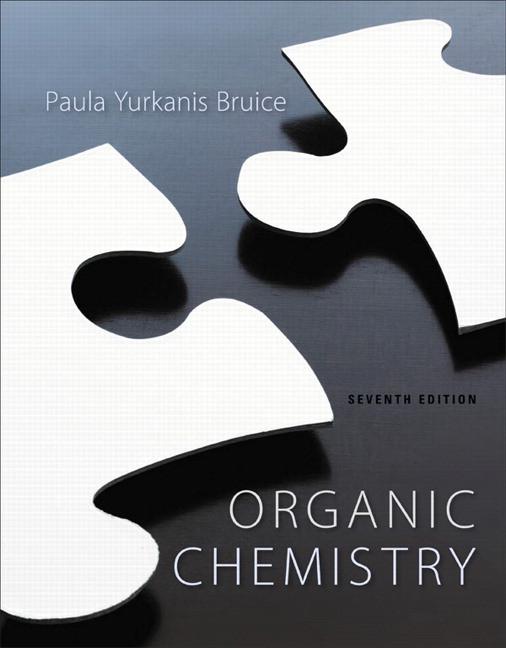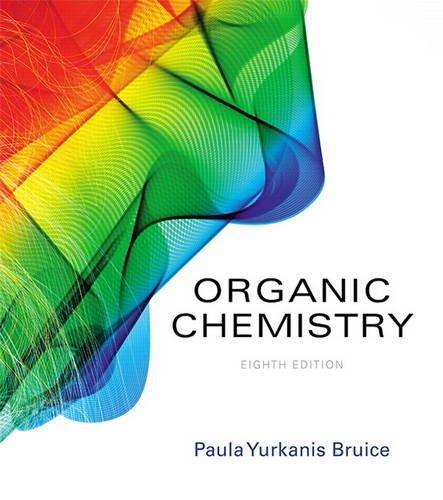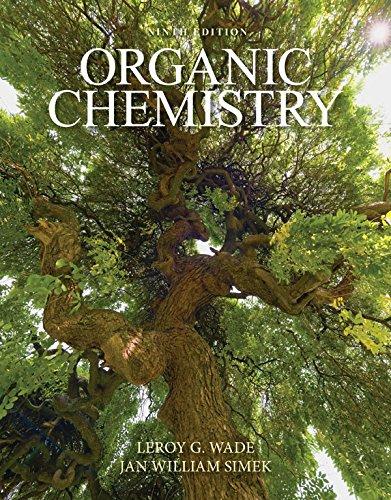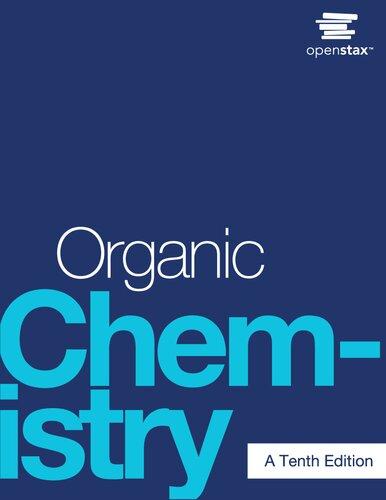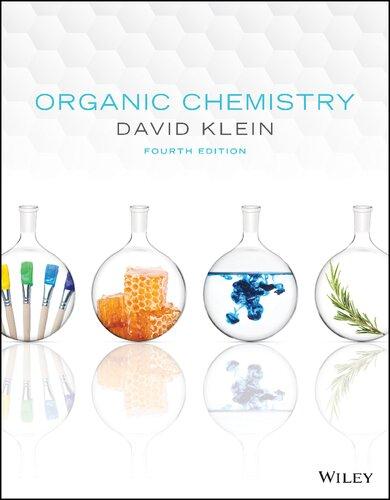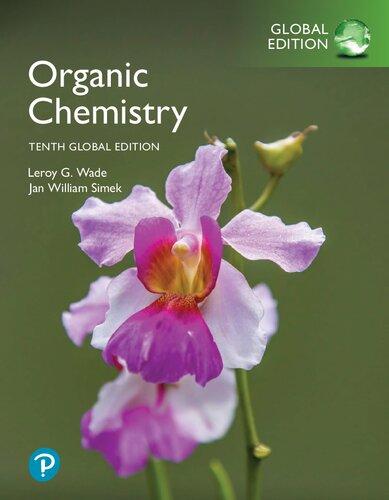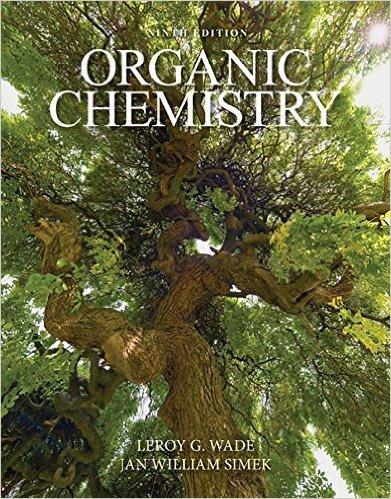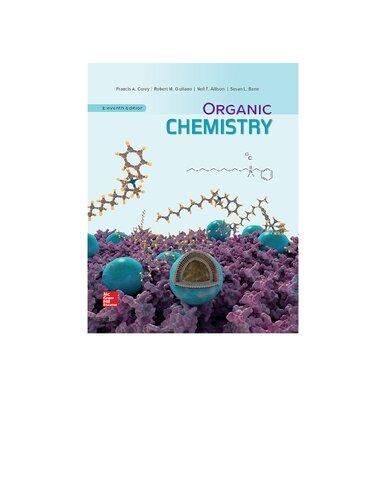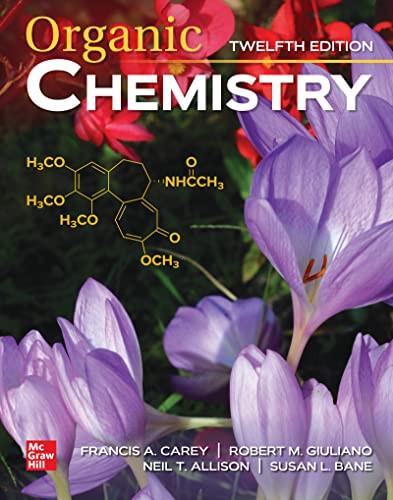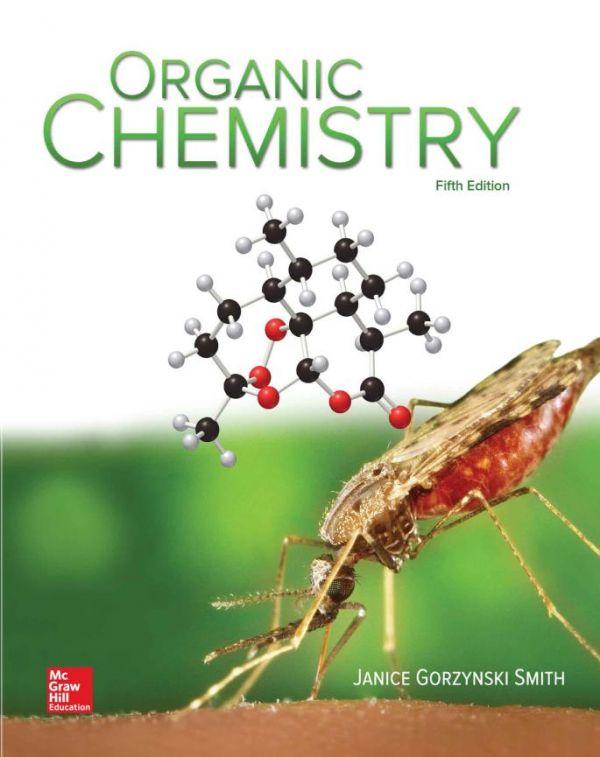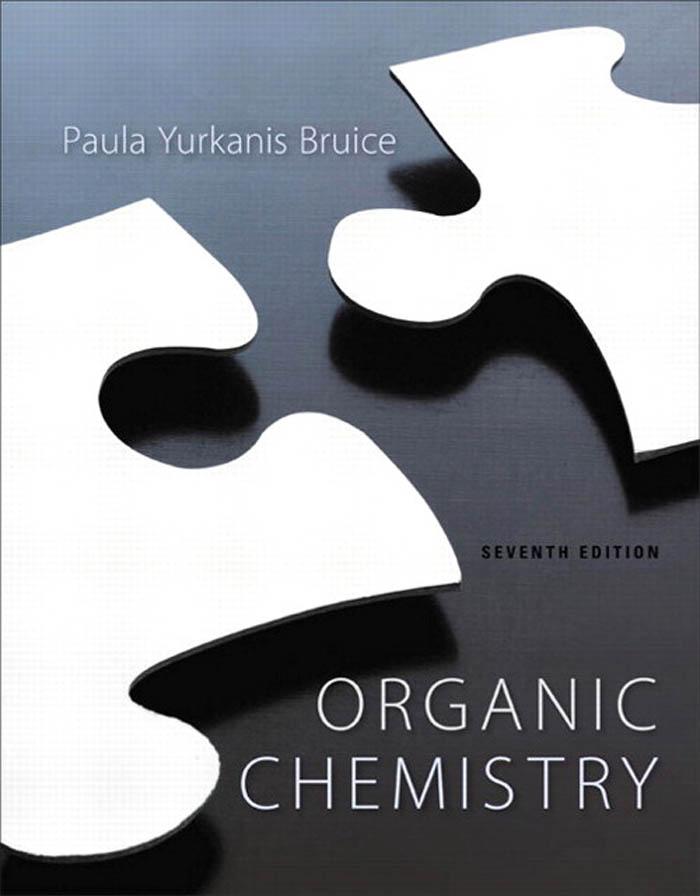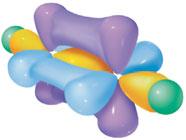To the Student
Welcome to the fascinating world of organic chemistry. You are about to embark on an exciting journey. This book has been written with students like you in mind—those who are encountering the subject for the first time. The book’s central goal is to make this journey through organic chemistry both stimulating and enjoyable by helping you understand central principles and asking you to apply them as you progress through the pages. You will be reminded about these principles at frequent intervals in references back to sections you have already mastered.
You should start by familiarizing yourself with the book. Inside the back cover is information you may want to refer to often during the course. The list of Some Important Things to Remember and the Reaction Summary at each chapter’s end provide helpful checklists of the concepts you should understand after studying the chapter. The Glossary at the end of the book can also be a useful study aid, as can the Appendices, which consolidate useful categories of information. The molecular models and electrostatic potential maps that you will find throughout the book are provided to give you an appreciation of what molecules look like in three dimensions and to show how charge is distributed within a molecule. Think of the margin notes as the author’s opportunity to inject personal reminders of ideas and facts that are important to remember. Be sure to read them.
Work all the problems within each chapter. These are drill problems that you will find at the end of each section that allow you to check whether you have mastered the skills and concepts the particular section is teaching before you go on to the next section. Some of these problems are solved for you in the text. Short answers to some of the others—those marked with a diamond—are provided at the end of the book. Do not overlook the “Problem-Solving Strategies” that are also sprinkled throughout the text; they provide practical suggestions on the best way to approach important types of problems.
In addition to the within-chapter problems, work as many end-of-chapter problems as you can. The more problems you work, the more comfortable you will be with the subject matter and the better prepared you will be for the material in subsequent chapters. Do not let any problem frustrate you. If you cannot figure out the answer in a reasonable amount of time, turn to the Study Guide and Solutions Manual to learn how you should have approached the problem. Later on, go back and try to work the problem on your own again. Be sure to visit www.MasteringChemistry. com, where you can explore study tools including Exercise Sets, an Interactive Molecular Gallery, Biographical Sketches of historically important chemists, and where you can access content on many important topics.
The most important advice to remember (and follow) in studying organic chemistry is DO NOT FALL BEHIND! The individual steps to learning organic chemistry are quite simple; each by itself is relatively easy to master. But they are numerous, and the subject can quickly become overwhelming if you do not keep up.
Before many of the theories and mechanisms were figured out, organic chemistry was a discipline that could be mastered only through memorization. Fortunately, that is no longer true. You will find many unifying ideas that allow you to use what you have learned in one situation to predict what will happen in other situations. So, as you read the book and study your notes, always making sure that you understand why each chemical event or behavior happens. For example, when the reasons behind reactivity are understood, most reactions can be predicted. Approaching the course with the misconception that to succeed you must memorize hundreds of unrelated reactions could be your downfall. There is simply too much material to memorize. Understanding and reasoning, not memorization, provide the necessary foundation on which to lay subsequent learning. Nevertheless, from time to time some memorization will be required: some fundamental rules will have to be memorized, and you will need to learn the common names of a number of organic compounds. But that should not be a problem; after all, your friends have common names that you have been able to learn and remember.
Students who study organic chemistry to gain entrance into medical school sometimes wonder why medical schools pay so much attention to this topic. The importance of organic chemistry is not in the subject matter alone, however. Mastering organic chemistry requires a thorough understanding of certain fundamental principles and the ability to use those fundamentals to analyze, classify, and predict. The study of medicine makes similar demands: a physician uses an understanding of certain fundamental principles to analyze, classify, and diagnose.
Good luck in your study. I hope you will enjoy studying organic chemistry and learn to appreciate the logic of this fascinating discipline. If you have any comments about the book or any suggestions for improving it, I would love to hear from you. Remember, positive comments are the most fun, but negative comments are the most useful.
Paula Yurkanis Bruice pybruice@chem.ucsb.edu
Medical Applications
Fosamax Prevents Bones from Being Nibbled Away (2.8)
Aspirin Must Be in its Basic Form to be Physiologically Active (2.10)
Blood: A Buffered Solution (2.11)
Drugs Bind to Their Receptors (3.9)
Cholesterol and Heart Disease (3.15)
How High Cholesterol is Clinically Treated (3.15)
The Enantiomers of Thalidomide (6.17)
Synthetic Alkynes Are Used to Treat Parkinson’s Disease (7.0)
Synthetic Alkynes Are Used for Birth Control (7.1)
S-Adenosylimethionine: A Natural Antidepressant (9.9)
The Inability to Perform an SN2 Reaction Causes a Severe Clinical Disorder (11.3)
Treating Alcoholism with Antabuse (11.5)
Methanol Poisoning (11.5)
Anesthetics (11.6)
Benzo[a]pyrene and Cancer (11.8)
Chimney Sweeps and Cancer (11.8)
Lead Compounds for the Development of Drugs (11.9)
Alkylating Agents as Cancer Drugs (11.11)
Is Chocolate a Health Food? (13.11)
Artificial Blood (13.12)
Nature’s Sleeping Pill (16.1)
Aspirin, NSAIDs, and Cox-2 Inhibitors (16.11)
The Discovery of Penicillin (16.15)
Penicillin and Drug Resistance (16.15)
Penicillins in Clinical Use (16.15)
Dissolving Sutures (16.21)
Serendipity in Drug Development (17.10)
Cancer Chemotherapy (17.18)
Breast Cancer and Aromatase Inhibitors (18.12)
Discovery of the First Antibiotic (19.22)
Drug Safety (19.22)
Nitrosamines and Cancer (19.23)
Thyroxine (19.5)
Searching for Drugs: An Antihistamine, a Nonsedating Antihistamine, and a Drug for Ulcers (20.7)
Porphyrin, Bilirubin, and Jaundice (20.7)
Measuring the Blood Glucose Levels in Diabetes (21.8)
Lactose Intolerance (21.15)
Galactosemia (21.15)
Why the Dentist is Right (21.16)
Bacterial Resistance (21.17)
Heparin–A Natural Anticoagulant (21.17)
Vitamin C (21.17)
Amino Acids and Disease (22.2)
A Peptide Antibiotic (22.2)
Diabetes (22.8)
Diseases Caused by a Misfolded Protein (22.15)
How Tamiflu Works (23.10)
Niacin Deficiency (24.1)
Assessing the Damage After a Heart Attack (24.5)
The First Antibiotics (24.7)
Cancer Drugs and Side Effects (24.7)
Anticoagulants (24.8)
Phenylketonuria (PKU): An Inborn Error of Metabolism (25.9)
Alcaptonuria (25.9)
Basal Metabolic Rate (25.11)
How Statins Lower Cholesterol Levels (25.17)
Sickle Cell Anemia (26.9)
Antibiotics That Act by Inhibiting Translation (26.9)
Three Different Antibiotics Act by a Common Mechanism (26.10)
Influenza Pandemics (26.11)
The X Prize (26.12)
Nanocontainers (27.5)
Melamine Poisoning (27.8)
Health Concerns: Bisphenol A and Phthalates (27.8)
The Sunshine Vitamin (29.6)
Biological Applications
Poisonous Amines (2.3)
Cell Membranes (3.9)
Pheromones (5.0)
Trans Fats (6.12)
How a Banana Slug Knows What to Eat (7.2)
Electron Delocalization Affects the ThreeDimensional Shape of Proteins (8.5)
DDT: A Synthetic Organohalide That Kills Disease-Spreading Insects (9.0)
Naturally Occurring Organohalides That Defend Against Predators (10.0)
Biological Dehydrations (11.4)
Alkaloids (11.9)
Whales and Echolocation (16.13)
Snake Venom (16.13)
Phosphoglycerides Are Components of Membranes (16.13)
A Semisynthetic Penicillin (16.15)
Dalmatians: Do Not Fool with Mother Nature (16.16)
Preserving Biological Specimens (17.11)
A Biological Friedel-Crafts Alkylation (19.8)
Controlling Fleas (21.16)
Primary Structure and Taxonomic Relationship (22.12)
Competitive Inhibitors (24.7)
There Are More Than Four Bases in DNA (26.7)
Chemical Applications
Natural Organic Compounds versus Synthetic Organic Compounds (1.0)
Diamond, Graphite, Graphene, and Fullerenes: Substances Containing Only Carbon Atoms (1.8)
Water—A Unique Compound (1.12)
Acid Rain (2.2)
Bad Smelling Compounds (3.7)
Von Baeyer, Barbituric Acid, and Blue Jeans (3.11)
Starch and Cellulose—Axial and Equatorial (3.13)
Cis-Trans Interconversion in Vision (4.1)
The Difference Between ∆G‡ and E a (5.9)
Borane and Diborane (6.8)
Cyclic Alkenes (6.15)
Chiral Catalysts (6.16)
Chiral Drugs (4.15)
Sodium Amide and Sodium in Ammonia (7.10)
Green Chemistry: Aiming for Sustainability (7.12)
Buckyballs (8.9)
Organic Compounds That Conduct Electricity (8.13)
Why Are Living Organisms Composed of Carbon Instead of Silicon? (9.2)
Solvation Effects (9.7)
Eradicating Termites (9.7)
The Lucas Test (11.1)
Crown Ethers: Another Example of Molecular Recognition (11.7)
Crown Ethers Can be Used to Catalyze SN2 Reactions (11.7)
Mustard–A Chemical Warfare Agent (11.11)
Cyclopropane (13.9)
What Makes Blueberries Blue and Strawberries Red? (14.21)
Omega Fatty Acids (16.4)
Waxes Are Esters That Have High-Molecular Weights (16.9)
Synthetic Polymers (16.21)
Nerve Impulses, Paralysis, and Insecticides (16.23)
Enzyme-Catalyzed Carbonyl Additions (17.14)
Carbohydrates (17.12)
b-Carotene (17.16)
Synthesizing Organic Compounds (17.17)
Semisynthetic Drugs (17.17)
Enzyme-Catalyzed Cis-Trans Interconversion (17.18)
The Synthesis of Aspirin (18.7)
Measuring Toxicity (19.0)
Incipient Primary Carbocations (19.8)
Synthetic Polymers (16.21)
Olestra: Nonfat with Flavor (21.11)
Hair: Straight or Curly? (22.8)
Right-Handed and Left-Handed Helices (22.14)
b-Peptides: An Attempt to Improve on Nature (22.14)
Too Much Broccoli (24.8)
Why Did Nature Choose Phosphates? (25.1)
Protein Prenylation (25.17)
Natural Products That Modify DNA (26.6)
Resisting Herbicides (26.14)
Designing a Polymer (27.8)
Luminescence (29.6)
A Biological Reaction That Involves an Electrocyclic Reaction Followed by a Sigmatropic Rearrangement (29.6)
General Applications
Derivation of the Henderson-Hasselbalch Equation (2.10)
How is the Octane Number of Gasoline Determined? (3.2)
A Few Words About Curved Arrows (5.6)
Calculating Kinetic Parameters (End of Ch 05)
Which are More Harmful, Natural Pesticides or Synthetic Pesticides? (6.18)
Why Are Drugs so Expensive? (7.0)
Kekule’s Dream (8.1)
Environmental Adaptation (9.7)
The Nobel Prize (10.8)
Grain Alcohol and Wood Alcohol (11.1)
Blood Alcohol Content (11.5)
Natural Gas and Petroleum (13.1)
Fossil Fuels: A Problematic Energy Source (13.1)
Why Radicals No Longer Have to Be Called Free Radicals (13.2)
Decaffinated Coffee and the Cancer Scare (13.11)
Food Preservatives (13.11)
Mass Spectrometry in Forensics (14.8)
The Originator of Hooke’s Law (14.13)
Ultraviolet Light and Sunscreens (14.18)
Nikola Tesla (15.1)
Structural Databases (15.24)
Soaps and Micelles (16.13)
What Drug-Enforcement Dogs Are Really Detecting (16.20)
Butanedione: An Unpleasant Compound (17.1)
The Toxicity of Benzene (19.1)
Glucose/Dextrose (21.9)
Acceptable Daily Intake (21.19)
Proteins and Nutrition (22.1)
Water Softeners: Examples of Cation-Exchange Chromatography (22.3)
Vitamin B1 (24.0)
Curing A Hangover with Vitamin B1 (24.3)
Differences in Metabolism (25.0)
The Structure of DNA: Watson, Crick, Franklin, and Wilkins (26.1)
DNA Fingerprinting (26.13)
Teflon: An Accidental Discovery (27.2)
Recycling Symbols (27.2)
Brief Table of Contents
Preface xx
CHAPTER1 Remembering General Chemistry: Electronic Structure and Bonding 2
CHAPTER2 Acids and Bases: Central to Understanding Organic Chemistry 53
TUTORIAL Acids and Bases 82
CHAPTER3 An Introduction to Organic Compounds: Nomenclature, Physical Properties, and Representation of Structure 90
TUTORIAL Using Molecular Models 146
CHAPTER4 Isomers: The Arrangement of Atoms in Space 147
TUTORIAL Interconverting Structural Representations 187
CHAPTER5 Alkenes: Structure, Nomenclature, and an Introduction to Reactivity • Thermodynamics and Kinetics 190
TUTORIAL An Exercise in Drawing Curved Arrows: Pushing Electrons 225
CHAPTER6 The Reactions of Alkenes: The Stereochemistry of Addition Reactions 236
CHAPTER7 The Reactions of Alkynes • An Introduction to Multistep Synthesis 299
CHAPTER8 Delocalized Electrons and Their Effect on Stability, pKa, and the Products of a Reaction 330
TUTORIAL Drawing Resonance Contributors 392
CHAPTER9 Substitution Reactions of Alkyl Halides 402
CHAPTER10 Elimination Reactions of Alkyl Halides • Competition Between Substitution and Elimination 444
CHAPTER11 Reactions of Alcohols, Ethers, Epoxides, Amines, and Thiols 481
CHAPTER12 Organometallic Compounds 535
CHAPTER13 Radicals • Reactions of Alkanes 556
TUTORIAL Drawing Curved Arrows in Radical Systems 590
CHAPTER14 Mass Spectrometry, Infrared Spectroscopy, and Ultraviolet/ Visible Spectroscopy 595
CHAPTER15 NMR Spectroscopy 649
CHAPTER16 Reactions of Carboxylic Acids and Carboxylic Derivatives 720
CHAPTER17 Reactions of Aldehydes and Ketones • More Reactions of Carboxylic Acid Derivatives • Reactions of a , b- Unsaturated Carbonyl Compounds 789
CHAPTER18 Reactions at the a -Carbon of Carbonyl Compounds 853
CHAPTER19 Reactions of Benzene and Substituted Benzenes 907
TUTORIAL Synthesis and Retrosynthetic Analysis 974
CHAPTER20 More About Amines • Reactions of Heterocyclic Compounds 989
CHAPTER21 The Organic Chemistry of Carbohydrates 1017
CHAPTER22 The Organic Chemistry of Amino Acids, Peptides, and Proteins 1053
CHAPTER23 Catalysis in Organic Reaction and in Enzymatic Reactions 1099
CHAPTER24 The Organic Chemistry of the Coenzymes, Compounds Derived from Vitamins 1132
CHAPTER25 The Organic Chemistry of the Metabolic Pathways • Terpene Biosynthesis 1170
CHAPTER26 The Chemistry of the Nucleic Acids 1207
CHAPTER27 Synthetic Polymers 1236
CHAPTER28 Pericyclic Reactions 1266
APPENDICESI pK a Values A-1
II Kinetics A-3
III Summary of Methods Used to Synthesize a Particular Functional Group A-8
IV Summary of Methods Employed to Form Carbon-Carbon Bonds A-11
Answers to Selected Problems Available in the Study Area in MasteringChemistry
Glossary G-1
Photo Credits P-1
Index I-1
New material on how to draw Lewis structures and how to predict bond angles and the orbitals used in bonding.
PART1
1
AN INTRODUCTION TO THE STUDY OF ORGANIC CHEMISTRY 1
Remembering General Chemistry: Electronic Structure and Bonding 2
1.1 The Structure of an Atom 4
1.2 How the Electrons in an Atom Are Distributed 5
1.3 Ionic and Covalent Bonds 7
1.4 How the Structure of a Compound Is Represented 14
PROBLEM-SOLVING STRATEGY 17
1.5 Atomic Orbitals 21
1.6 An Introduction to Molecular Orbital Theory 23
1.7 How Single Bonds Are Formed in Organic Compounds 28
1.8 How a Double Bond Is Formed: The Bonds in Ethene 31
1.9 How a Triple Bond Is Formed: The Bonds in Ethyne 34
1.10 The Bonds in the Methyl Cation, the Methyl Radical, and the Methyl Anion 36
1.11 The Bonds in Ammonia and in the Ammonium Ion 37
1.12 The Bonds in Water 38
1.13 The Bond in a Hydrogen Halide 40
1.14 Hybridization and Molecular Geometry 42
PROBLEM-SOLVING STRATEGY 42
1.15 Summary: Hybridization, Bond Lengths, Bond Strengths, and Bond Angles 43
PROBLEM-SOLVING STRATEGY 47
1.16 The Dipole Moments of Molecules 47
SOME IMPORTANT THINGS TO REMEMBER 48 ■ PROBLEMS 49
New chapter on Acid/ Base Chemistry reinforces fundamental concepts.
New tutorial on Acid/ Base Chemistry provides students with opportunities to self assess and develop foundational skills needed for future topics in organic chemistry.
Enhanced by
• Acids and Bases: Equilibrium Basics
• Acids and Bases: Factors Influencing Acid Strength
• Acids and Bases: pH Influence on Acid and Base Structure
2
Acids and Bases:
Central to Understanding Organic Chemistry 53
2.1 An Introduction to Acids and Bases 53
2.2 pK a and pH 55
PROBLEM-SOLVING STRATEGY 56
2.3 Organic Acids and Bases 57
PROBLEM-SOLVING STRATEGY 60
2.4 How to Predict the Outcome of an Acid–Base Reaction 61
2.5 How to Determine the Position of Equilibrium 61
2.6 How the Structure of an Acid Affects its pK a Value 63
2.7 How Substituents Affect the Strength of an Acid 66
PROBLEM-SOLVING STRATEGY 67
2.8 An Introduction to Delocalized Electrons 68
2.9 A Summary of the Factors that Determine Acid Strength 70
2.10 How pH Affects the Structure of an Organic Compound 72
PROBLEM-SOLVING STRATEGY 72
2.11 Buffer Solutions 76
2.12 Lewis Acids and Bases 77
SOME IMPORTANT THINGS TO REMEMBER 78 ■ PROBLEMS 79
TUTORIAL
ACIDS AND BASES 82
3
An Introduction to Organic Compounds: Nomenclature, Physical Properties, and Representation of Structure 90
3.1 How Alkyl Substituents Are Named 94
3.2 The Nomenclature of Alkanes 97
3.3 The Nomenclature of Cycloalkanes • Skeletal Structures 101
PROBLEM-SOLVING STRATEGY 103
3.4 The Nomenclature of Alkyl Halides 104
3.5 The Nomenclature of Ethers 105
3.6 The Nomenclature of Alcohols 106
3.7 The Nomenclature of Amines 109
3.8 The Structures of Alkyl Halides, Alcohols, Ethers, and Amines 112
Increased content on noncovalent interactions in chemical and biological systems.
3.9 The Physical Properties of Alkanes, Alkyl Halides, Alcohols, Ethers, and Amines 113
PROBLEM-SOLVING STRATEGY 117
3.10 Rotation Occurs About Carbon–Carbon Single Bonds 121
3.11 Some Cycloalkanes Have Angle Strain 125
PROBLEM-SOLVING STRATEGY 126
3.12 Conformers of Cyclohexane 127
3.13 Conformers of Monosubstituted Cyclohexanes 130
PROBLEM-SOLVING STRATEGY 133
3.14 Conformers of Disubstituted Cyclohexanes 133
3.15 Fused Cyclohexane Rings 137
SOME IMPORTANT THINGS TO REMEMBER 139 ■ PROBLEMS 140
PART2
TUTORIAL
4
ELECTROPHILIC ADDITION REACTIONS, STEREOCHEMISTRY, AND ELECTRON DELOCALIZATION 145
USING MOLECULAR MODELS 146
Isomers: The Arrangement of Atoms in Space 147
4.1 Cis–Trans Isomers Result From Restricted Rotation 148
4.2 A Chiral Object Has a Nonsuperimposable Mirror Image 151
4.3 An Asymmetric Center Is a Cause of Chirality in a Molecule 152
4.4 Isomers with One Asymmetric Center 153
4.5 Asymmetric Centers and Stereocenters 154
4.6 How to Draw Enantiomers 154
4.7 Naming Enantiomers by the R,S System 155
PROBLEM-SOLVING STRATEGY 158
PROBLEM-SOLVING STRATEGY 158
4.8 Chiral Compounds Are Optically Active 160
4.9 How Specific Rotation Is Measured 161
4.10 Enantiomeric Excess 163
4.11 Compounds with More than One Asymmetric Center 164
4.12 Stereoisomers of Cyclic Compounds 167
PROBLEM-SOLVING STRATEGY 168
4.13 Meso Compounds Have Asymmetric Centers but Are Optically Inactive 169
PROBLEM-SOLVING STRATEGY 171
4.14 How to Name Isomers with More than One Asymmetric Center 173
PROBLEM-SOLVING STRATEGY 175
4.15 How Enantiomers Can Be Separated 178
4.16 Nitrogen and Phosphorus Atoms Can Be Asymmetric Centers 180
SOME IMPORTANT THINGS TO REMEMBER 181 ■ PROBLEMS 181
Enhanced by
• Using Molecular Models: Basics of Model Building
• Using Molecular Models: Interpret Chiral Models
• Using Molecular Models: Interpret Cyclic Models
The coverage of stereoisomers now precedes the coverage of the reactions of alkenes.
Two new tutorials reinforce student understanding and visualization of structure.
Enhanced by
• Interconverting Structural Representations: Interpreting Fischer Projections
• Interconverting Structural Representations: Fischer Projections with Multiple Stereocenters
• Interconverting Structural Representations: Interpreting Newman Projections
Introduces a new feature, "Organizing What We Know," which highlights how all organic compounds can be divided into families and all members of a family react in the same way Furthermore, each family can be put into one of four groups and all the families in a group react in similar ways
5
Alkenes:
Structure, Nomenclature, and an Introduction to Reactivity • Thermodynamics and Kinetics 190
5.1 Molecular Formulas and the Degree of Unsaturation 191
5.2 The Nomenclature of Alkenes 192
5.3 The Structure of Alkenes 195
5.4 Naming Alkenes Using the E,Z System 196
PROBLEM-SOLVING STRATEGY 199
PROBLEM-SOLVING STRATEGY 200
5.5 How an Organic Compound Reacts Depends on its Functional Group 200
5.6 How Alkenes React • Curved Arrows Show the Flow of Electrons 201
5.7 Thermodynamics and Kinetics 205
5.8 The Rate of a Chemical Reaction 212
5.9 The Difference Between the Rate of a Reaction and the Rate Constant for a Reaction 213
5.10 A Reaction Coordinate Diagram Describes the Energy Changes that Take Place during a Reaction 216
New tutorial gives students practice drawing curved arrows.
Enhanced by
• An Exercise in Drawing Curved Arrows: Basics of Pushing Electrons
• An Exercise in Drawing Curved Arrows: Predicting Electron Movement
• An Exercise in Drawing Curved Arrows: Interpreting Electron Movement
Alkoxymercuration was removed since it is now rarely used because of toxicity concerns. Ozonolysis has been added as has using 9-BBN for hydroboration and MCPBA for epoxidation.
5.11 Catalysis 218
5.12 Catalysis by Enzymes 219
SOME IMPORTANT THINGS TO REMEMBER 220 ■ PROBLEMS 221
TUTORIAL
6
Discussion of reactivity has been reorganized and clarified. The mechanism for keto-enol interconversion has been added.
AN EXERCISE IN DRAWING CURVED ARROWS: PUSHING ELECTRONS 225
The Reactions of Alkenes • The Stereochemistry of Addition Reactions 236
6.1 The Addition of a Hydrogen Halide to an Alkene 237
6.2 Carbocation Stability Depends on the Number of Alkyl Groups Attached to the Positively Charged Carbon 238
6.3 What Does the Structure of the Transition State Look Like? 240
6.4 Electrophilic Addition Reactions Are Regioselective 242
PROBLEM-SOLVING STRATEGY 245
6.5 The Addition of Water to an Alkene 246
6.6 The Addition of an Alcohol to an Alkene 248
6.7 A Carbocation Will Rearrange if it Can Form a More Stable Carbocation 250
6.8 The Addition of Borane to an Alkene: Hydroboration–Oxidation 252
6.9 The Addition of a Halogen to an Alkene 256
PROBLEM-SOLVING STRATEGY 260
6.10 The Addition of a Peroxyacid to an Alkene 260
6.11 The Addition of Ozone to an Alkene: Ozonolysis 262
PROBLEM-SOLVING STRATEGY 264
6.12 The Addition of Hydrogen to an Alkene 266
PROBLEM-SOLVING STRATEGY 269
6.13 The Relative Stabilities of Alkenes 269
6.14 Regioselective, Stereoselective, and Stereospecific Reactions 271
6.15 The Stereochemistry of Electrophilic Addition Reactions of Alkenes 272
PROBLEM-SOLVING STRATEGY 282
6.16 The Stereochemistry of Enzyme-Catalyzed Reactions 284
6.17 Enantiomers Can Be Distinguished by Biological Molecules 286
6.18 Reactions and Synthesis 288
SOME IMPORTANT THINGS TO REMEMBER 290
SUMMARY OF REACTIONS 291 ■ PROBLEMS 292
The
Reactions
of Alkynes
An Introduction to Multistep Synthesis 299
7.1 The Nomenclature of Alkynes 301
7.2 How to Name a Compound That Has More than One Functional Group 303
7.3 The Physical Properties of Unsaturated Hydrocarbons 305 7.4 The Structure of Alkynes 305
7.5 Alkynes Are Less Reactive than Alkenes 306
7.6 The Addition of Hydrogen Halides and the Addition of Halogens to an Alkyne 308
7.7 The Addition of Water to an Alkyne 311
7.8 The Addition of Borane to an Alkyne: Hydroboration–Oxidation 313
7.9 The Addition of Hydrogen to an Alkyne 314
7.10 A Hydrogen Bonded to an sp Carbon Is “Acidic” 316
PROBLEM-SOLVING STRATEGY 317
7.11 Synthesis Using Acetylide Ions 318
7.12 An Introduction to Multistep Synthesis 319
SOME IMPORTANT THINGS TO REMEMBER 325
SUMMARY OF REACTIONS 325 ■ PROBLEMS 326
8Delocalized Electrons and Their Effect on Stability,
pKa, and the
Products of a Reaction
8.1 Delocalized Electrons Explain Benzene’s Structure 331
330
8.2 The Bonding in Benzene 333
8.3 Resonance Contributors and the Resonance Hybrid 334
8.4 How to Draw Resonance Contributors 335
8.5 The Predicted Stabilities of Resonance Contributors 338
8.6 Delocalization Energy Is the Additional Stability Delocalized Electrons Give to a Compound 341
PROBLEM-SOLVING STRATEGY 342
8.7 Benzene Is an Aromatic Compound 343
8.8 The Two Criteria for Aromaticity 343
8.9 Applying the Criteria for Aromaticity 344
PROBLEM-SOLVING STRATEGY 347
8.10 Aromatic Heterocyclic Compounds 347
8.11 Antiaromaticity 349
8.12 A Molecular Orbital Description of Aromaticity and Antiaromaticity 350
8.13 More Examples that Show How Delocalized Electrons Increase Stability 351
8.14 A Molecular Orbital Description of Stability 356
8.15 How Delocalized Electrons Affect pK a Values 360
PROBLEM-SOLVING STRATEGY 362
8.16 Delocalized Electrons Can Affect the Product of a Reaction 364
8.17 Reactions of Dienes 365
8.18 Thermodynamic versus Kinetic Control 369
8.19 The Diels–Alder Reaction Is a 1,4-Addition Reaction 374
8.20 Retrosynthetic Analysis of the Diels–Alder Reaction 380
8.21 Organizing What We Know About the Reactions of Organic Compounds 381
SOME IMPORTANT THINGS TO REMEMBER 382
SUMMARY OF REACTIONS 383 ■ PROBLEMS 384
TUTORIAL
PART3
DRAWING RESONANCE CONTRIBUTORS 392
SUBSTITUTION AND ELIMINATION REACTIONS 401
9 Substitution Reactions of Alkyl Halides 402
9.1 The Mechanism for an SN2 Reaction 404
9.2 Factors that Affect SN2 Reactions 409
9.3 The Mechanism for an SN1 Reaction 417
9.4 Factors that Affect SN1 Reactions 420
9.5 Benzylic Halides, Allylic Halides, Vinylic Halides, and Aryl Halides 421
PROBLEM-SOLVING STRATEGY 423
DESIGNING A SYNTHESIS I
Discussion of aromaticity has been added to allow this concept to be carried throughout the text starting at an earlier point.
New tutorial gives students practice drawing resonance contributors.
Enhanced by
• Drawing Resonance Contributors: Moving p Electrons
• Drawing Resonance Contributors: Predicting Contributor Structure
• Drawing Resonance Contributors: Substituted Benzene Compounds
Rewritten to incorporate the new finding that secondary alkyl halides do not undergo SN1 reactions.
Rewritten to incorporate the new finding that secondary alkyl halides do not undergo E1 reactions.
9.6 Competition Between SN2 and SN1 Reactions 424
PROBLEM-SOLVING STRATEGY 426
9.7 The Role of the Solvent in SN1 and SN2 Reactions 428
9.8 Intermolecular versus Intramolecular Reactions 433
PROBLEM-SOLVING STRATEGY 435
9.9 Methylating Agents Used by Chemists versus Those Used by Cells 436
SOME IMPORTANT THINGS TO REMEMBER 438
SUMMARY OF REACTIONS 439 ■ PROBLEMS 439
10
Elimination Reactions of Alkyl Halides • Competition Between Substitution and Elimination 444
10.1 The E2 Reaction 445
10.2 An E2 Reaction Is Regioselective 446
10.3 The E1 Reaction 452
PROBLEM-SOLVING STRATEGY 455
10.4 Benzylic and Allylic Halides 455
10.5 Competition Between E2 and E1 Reactions 456
10.6 E2 and E1 Reactions Are Stereoselective 457
PROBLEM-SOLVING STRATEGY 460
10.7 Elimination from Substituted Cyclohexanes 462
10.8 A Kinetic Isotope Effect Can Help Determine a Mechanism 465
10.9 Competition Between Substitution and Elimination 466
10.10 Substitution and Elimination Reactions in Synthesis 471
10.11 Approaching the Problem 474
Hypochlorous acid introduced as an alternative to toxic-chromuiumcontaining compounds.
11
SOME IMPORTANT THINGS TO REMEMBER 476
SUMMARY OF REACTIONS 477 ■ PROBLEMS 477
Reactions
of Alcohols, Ethers, Epoxides,
Amines, and Thiols 481
11.1 Nucleophilic Substitution Reactions of Alcohols: Forming Alkyl Halides 482
11.2 Other Methods Used to Convert Alcohols into Alkyl Halides 487
11.3 Converting an Alcohol Into a Sulfonate Ester 488
11.4 Elimination Reactions of Alcohols: Dehydration 492
PROBLEM-SOLVING STRATEGY 495
11.5 Oxidation of Alcohols 499
11.6 Nucleophilic Substitution Reactions of Ethers 502
11.7 Nucleophilic Substitution Reactions of Epoxides 505
11.8 Arene Oxides 512
11.9 Amines Do Not Undergo Substitution or Elimination Reactions 516
11.10 Quaternary Ammonium Hydroxides Undergo Elimination Reactions 519
DESIGNING A SYNTHESIS II
Discussion of palladiumcatalyzed coupling reactions and their mechanisms has been expanded. Solved problems and problemsolving strategies were added to facilitate understanding.
11.11 Thiols, Sulfides, and Sulfonium Salts 521
11.12
Organizing What We Know About the Reactions of Organic Compounds 524
SOME IMPORTANT THINGS TO REMEMBER 525
SUMMARY OF REACTIONS 526 ■ PROBLEMS 528
12
Organometallic Compounds 535
12.1 Organolithium and Organomagnesium Compounds 536
12.2 Transmetallation 538
12.3 Organocuprates 538
12.4 Palladium-Catalyzed Coupling Reactions 541
PROBLEM-SOLVING STRATEGY 546
12.5 Alkene Metathesis 548
SOME IMPORTANT THINGS TO REMEMBER 551
SUMMARY OF REACTIONS 552 ■ PROBLEMS 553
13
Radicals • Reactions of Alkanes 556
13.1 Alkanes Are Unreactive Compounds 556
13.2 The Chlorination and Bromination of Alkanes 558
Now includes the mechanism for the oxidation of fats and oils by oxygen.
13.3 Radical Stability Depends On the Number of Alkyl Groups Attached to the Carbon with the Unpaired Electron 560
13.4 The Distribution of Products Depends On Probability and Reactivity 561
13.5 The Reactivity–Selectivity Principle 564
PROBLEM-SOLVING STRATEGY 566
13.6 Formation of Explosive Peroxides 567
13.7 The Addition of Radicals to an Alkene 568
13.8 The Stereochemistry of Radical Substitution and Radical Addition Reactions 571
13.9 Radical Substitution of Benzylic and Allylic Hydrogens 573
13.10 More Practice With Multistep Synthesis 576
13.11 Radical Reactions Occur In Biological Systems 578
13.12 Radicals and Stratospheric Ozone 583
SOME IMPORTANT THINGS TO REMEMBER 585
SUMMARY OF REACTIONS 585 ■ PROBLEMS 586
TUTORIAL
PART4
14
DRAWING CURVED ARROWS IN RADICAL SYSTEMS 590
DESIGNING A SYNTHESIS III
IDENTIFICATION OF ORGANIC COMPOUNDS 594
Mass Spectrometry, Infrared Spectroscopy, and Ultraviolet/ Visible Spectroscopy 595
14.1 Mass Spectrometry 597
14.2 The Mass Spectrum • Fragmentation 598
14.3 Using the m/z Value of the Molecular Ion to Calculate the Molecular Formula 600
PROBLEM-SOLVING STRATEGY 601
14.4 Isotopes in Mass Spectrometry 602
14.5 High-Resolution Mass Spectrometry Can Reveal Molecular Formulas 603
14.6 The Fragmentation Patterns of Functional Groups 604
14.7 Other Ionization Methods 611
14.8 Gas Chromatography–Mass Spectrometry 611
14.9 Spectroscopy and the Electromagnetic Spectrum 611
14.10 Infrared Spectroscopy 614
14.11 Characteristic Infrared Absorption Bands 616
14.12 The Intensity of Absorption Bands 617
14.13 The Position of Absorption Bands 618
14.14 The Position and Shape of an Absorption Band Is Affected By Electron Delocalization, Electron Donation and Withdrawal, and Hydrogen Bonding 619
PROBLEM-SOLVING STRATEGY 622
14.15 The Absence of Absorption Bands 626
14.16 Some Vibrations Are Infrared Inactive 627
14.17 How to Interpret an Infrared Spectrum 629
14.18 Ultraviolet and Visible Spectroscopy 631
14.19 The Beer–Lambert Law 633
14.20 The Effect of Conjugation on l max 634
14.21 The Visible Spectrum and Color 635
14.22 Some Uses of UV/ VIS Spectroscopy 637
SOME IMPORTANT THINGS TO REMEMBER 639 ■ PROBLEMS 640
Enhanced by
• Curved Arrows in Radical Systems: Interpreting Electron Movement
• Curved Arrows in Radical Systems: Predicting Electron Movement
• Curved Arrows in Radical Systems: Resonance
Added the “rule of 13”.
There are now 50 additional spectroscopy problems in the Study Guide and Solutions Manual.
15 NMR Spectroscopy 649
15.1 An Introduction to NMR Spectroscopy 649
15.2 Fourier Transform NMR 652
15.3 Shielding Causes Different Hydrogens to Show Signals at Different Frequencies 653
15.4 The Number of Signals in an 1H NMR Spectrum 654
PROBLEM-SOLVING STRATEGY 655
15.5 The Chemical Shift Tells How Far the Signal Is from the Reference Signal 656
15.6 The Relative Positions of 1H NMR Signals 658
15.7 The Characteristic Values of Chemical Shifts 659
15.8 Diamagnetic Anisotropy 661
15.9 The Integration of NMR Signals Reveals the Relative Number of Protons Causing Each Signal 663
15.10 The Splitting of Signals Is Described by the N + 1 Rule 665
15.11 What Causes Splitting? 668
15.12 More Examples of 1H NMR Spectra 670
15.13 Coupling Constants Identify Coupled Protons 675
PROBLEM-SOLVING STRATEGY 677
15.14 Splitting Diagrams Explain the Multiplicity of a Signal 679
15.15 Diastereotopic Hydrogens are Not Chemically Equivalent 681
15.16 The Time Dependence of NMR Spectroscopy 683
15.17 Protons Bonded To Oxygen and Nitrogen 684
15.18 The Use of Deuterium in 1H NMR Spectroscopy 686
15.19 The Resolution of 1H NMR Spectra 687
15.20 13C NMR Spectroscopy 689
PROBLEM-SOLVING STRATEGY 692
Acid anhydrides are carboxylic acid derivatives but they don’t look like carboxylic acids. Anhydrides, therefore, were moved to the end of the chapter to allow students to focus on the similarities between carboxylic acids, acyl chlorides, esters, and amides. Acid anhydrides are now better placed since they come just before phosphoric acid anhydrides.
15.21 Dept 13C NMR Spectra 694
15.22 Two-Dimensional NMR Spectroscopy 695
15.23 NMR Used in Medicine Is Called Magnetic Resonance Imaging 698
15.24 X-Ray Crystallography 699
SOME IMPORTANT THINGS TO REMEMBER 701 ■ PROBLEMS 701
PART5
16
CARBONYL COMPOUNDS
Reactions of Carboxylic Acids and Carboxylic Derivatives 720
719
16.1 The Nomenclature of Carboxylic Acids and Carboxylic Acid Derivatives 722
16.2 The Structures of Carboxylic Acids and Carboxylic Acid Derivatives 726
16.3 The Physical Properties of Carbonyl Compounds 728
16.4 Fatty Acids Are Long-Chain Carboxylic Acids 729
16.5 How Carboxylic Acids and Carboxylic Acid Derivatives React 731
PROBLEM-SOLVING STRATEGY 733
16.6 The Relative Reactivities of Carboxylic Acids and Carboxylic Acid Derivatives 733
16.7 The General Mechanism for Nucleophilic Addition–Elimination Reactions 736
16.8 The Reactions of Acyl Chlorides 737
16.9 The Reactions of Esters 739
16.10 Acid-Catalyzed Ester Hydrolysis and Transesterification 741
16.11 Hydroxide-Ion-Promoted Ester Hydrolysis 746
16.12 How the Mechanism for Nucleophilic Addition–Elimination Was Confirmed 749
16.13 Fats and Oils Are Triglycerides 751
16.14 Reactions of Carboxylic Acids 755
PROBLEM-SOLVING STRATEGY 756
16.15 Reactions of Amides 757
16.16 Acid–Catalyzed Amide Hydrolysis and Alcoholysis 760
16.17 Hydroxide-Ion Promoted Hydrolysis of Amides 762
16.18 The Hydrolysis of an Imide: A Way to Synthesize Primary Amines 763
16.19 Nitriles 764
16.20 Acid Anhydrides 766
16.21 Dicarboxylic Acids 769
16.22 How Chemists Activate Carboxylic Acids 771
16.23 How Cells Activate Carboxylic Acids 773
SOME IMPORTANT THINGS TO REMEMBER 776
SUMMARY OF REACTIONS 777 ■ PROBLEMS 780
17
Reactions of Aldehydes and Ketones • More Reactions of Carboxylic Acid Derivatives • Reactions of A,B-Unsaturated Carbonyl Compounds 789
17.1 The Nomenclature of Aldehydes and Ketones 790
17.2 The Relative Reactivities of Carbonyl Compounds 793
17.3 How Aldehydes and Ketones React 795
17.4 The Reactions of Carbonyl Compounds with Gringard Reagents 796
PROBLEM-SOLVING STRATEGY 800
17.5 The Reactions of Carbonyl Compounds with Acetylide Ions 801
17.6 The Reactions of Aldehydes and Ketones with Cyanide Ion 801
17.7 The Reactions of Carbonyl Compounds with Hydride Ion 803
17.8 More About Reduction Reactions 808
17.9 Chemoselective Reactions 810
17.10 The Reactions of Aldehydes and Ketones with Amines 811
17.11 The Reactions of Aldehydes and Ketones with Water 817
17.12 The Reactions of Aldehydes and Ketones with Alcohols 820
PROBLEM-SOLVING STRATEGY 822
17.13 Protecting Groups 823
17.14 The Addition of Sulfur Nucleophiles 825
17.15 The Reactions of Aldehydes and Ketones with a Peroxyacid 826
17.16 The Wittig Reaction Forms an Alkene 827
17.17 Disconnections, Synthons, and Synthetic Equivalents 829
17.18 Nucleophilic Addition to a , b -Unsaturated Aldehydes and Ketones 832
17.19 Nucleophilic Addition to a , b -Unsaturated Carboxylic Acid Derivatives 837
DESIGNING A SYNTHESIS IV
Enhanced discussion of reduction reactions. Added a discussion of chemoselective reactions.
SOME IMPORTANT THINGS TO REMEMBER 838
SUMMARY OF REACTIONS 839 ■ PROBLEMS 843
18 Reactions at the A-Carbon of Carbonyl Compounds 853
18.1 The Acidity of an a -Hydrogen 854
PROBLEM-SOLVING STRATEGY 856
18.2 Keto–Enol Tautomers 857
18.3 Keto–Enol Interconversion 858
18.4 Halogenation of the a -Carbon of Aldehydes and Ketones 859
18.5 Halogenation of the a -Carbon of Carboxylic Acids: The Hell–Volhard–Zelinski Reaction 861
18.6 Forming an Enolate Ion 862
18.7 Alkylating the a -Carbon of Carbonyl Compounds 863
PROBLEM-SOLVING STRATEGY 865
18.8 Alkylating and Acylating the a -Carbon Using an Enamine Intermediate 866
18.9 Alkylating the b -Carbon: The Michael Reaction 867
18.10 An Aldol Addition Forms b -Hydroxyaldehydes or b -Hydroxyketones 869
18.11 The Dehydration of Aldol Addition Products Forms a , b -Unsaturated Aldehydes and Ketones 871
18.12 A Crossed Aldol Addition 872
18.13 A Claisen Condensation Forms a b -Keto Ester 875
18.14 Other Crossed Condensations 878
18.15 Intramolecular Condensations and Intramolecular Aldol Additions 879
18.16 The Robinson Annulation 881
PROBLEM-SOLVING STRATEGY 882
Streamlined the discussion of both the reactions of enolate ions and crossed aldol additions and condensations. Added new examples of retrosynthetic analysis.
New tutorial on synthesis and retrosynthetic analysis including two examples of a multistep synthesis from the literature.
Enhanced by
• Synthesis and Retrosynthetic Analysis: Functional Groups
• Synthesis and Retrosynthetic Analysis: Carbon Chain
• Synthesis and Retrosynthetic Analysis: Retrosynthesis of 2-Pentanone Using Reactions of Carbonyl Compounds
18.17 Carboxylic Acids with a Carbonyl Group at the 3-Position Can Be Decarboxylated 883
18.18 The Malonic Ester Synthesis: A Way to Synthesize a Carboxylic Acid 885
18.19 The Acetoacetic Ester Synthesis: A Way to Synthesize a Methyl Ketone 887
18.20 Making New Carbon–Carbon Bonds 888
18.21 Reactions at the a -Carbon in Living Systems 890
18.22 Organizing What We Know About the Reactions of Organic Compounds 894
SOME IMPORTANT THINGS TO REMEMBER 894
SUMMARY OF REACTIONS 895 ■ PROBLEMS 898
PART6
AROMATIC COMPOUNDS 906
19 Reactions of Benzene and Substituted Benzenes 907
19.1 The Nomenclature of Monosubstituted Benzenes 909
19.2 How Benzene Reacts 910
19.3 The General Mechanism for Electrophilic Aromatic Substitution Reactions 912
19.4 The Halogenation of Benzene 913
19.5 The Nitration of Benzene 916
19.6 The Sulfonation of Benzene 917
19.7 The Friedel–Crafts Acylation of Benzene 918
19.8 The Friedel–Crafts Alkylation of Benzene 920
19.9 The Alkylation of Benzene by Acylation–Reduction 922
19.10 Using Coupling Reactions to Alkylate Benzene 924
19.11 It Is Important to Have More than One Way to Carry Out a Reaction 924
19.12 How Some Substituents on a Benzene Ring Can Be Chemically Changed 925
19.13 The Nomenclature of Disubstituted and Polysubstituted Benzenes 927
19.14 The Effect of Substituents on Reactivity 929
19.15 The Effect of Substituents on Orientation 935
19.16 The Effect of Substituents on pK a 939
PROBLEM-SOLVING STRATEGY 940
19.17 The Ortho–Para Ratio 941
19.18 Additional Considerations Regarding Substituent Effects 941
19.19 The Synthesis of Monosubstituted and Disubstituted Benzenes 943
19.20 The Synthesis of Trisubstituted Benzenes 945
19.21 The Synthesis of Substituted Benzenes Using Arenediazonium Salts 947
19.22 The Arenediazonium Ion as an Electrophile 950
19.23 The Mechanism for the Reaction of Amines with Nitrous Acid 953
19.24 Nucleophilic Aromatic Substitution: An Addition–Elimination Reaction 955
19.25 The Synthesis of Cyclic Compounds 957
SOME IMPORTANT THINGS TO REMEMBER 959
SUMMARY OF REACTIONS 960 ■ PROBLEMS 962
TUTORIAL
20
SYNTHESIS AND RETROSYNTHETIC ANALYSIS 974
More About Amines • Reactions of Heterocyclic Compounds 989
20.1 More About Amine Nomenclature 990
20.2 More About the Acid–Base Properties of Amines 991
20.3 Amines React as Bases and as Nucleophiles 993
20.4 The Synthesis of Amines 994
20.5 Aromatic Five-Membered-Ring Heterocycles 994
20.6 Aromatic Six-Membered-Ring Heterocycles 999
PROBLEM-SOLVING STRATEGY 999
20.7 Some Amine Heterocycles Have Important Roles in Nature 1005
20.8 Organizing What We Know About the Reactions of Organic Compounds 1010
SOME IMPORTANT THINGS TO REMEMBER 1010
SUMMARY OF REACTIONS 1011 ■ PROBLEMS 1012
PART7
BIOORGANIC COMPOUNDS 1016
21
The Organic Chemistry of Carbohydrates 1017
21.1 The Classification of Carbohydrates 1018
21.2 The D and L Notation 1019
21.3 The Configurations of the Aldoses 1020
21.4 The Configurations of the Ketoses 1022
21.5 The Reactions of Monosaccharides in Basic Solutions 1023
21.6 The Oxidation–Reduction Reactions of Monosaccharides 1024
21.7 Lengthening the Chain: The Kiliani–Fischer Synthesis 1026
21.8 Shortening the Chain: The Wohl Degradation 1026
21.9 The Stereochemistry of Glucose: The Fischer Proof 1027
21.10 Monosaccharides Form Cyclic Hemiacetals 1030
21.11 Glucose Is the Most Stable Aldohexose 1032
21.12 Formation of Glycosides 1034
21.13 The Anomeric Effect 1036
21.14 Reducing and Nonreducing Sugars 1036
21.15 Disaccharides 1037
21.16 Polysaccharides 1040
21.17 Some Naturally Occurring Compounds Derived from Carbohydrates 1043
21.18 Carbohydrates on Cell Surfaces 1045
21.19 Artificial Sweeteners 1047
SOME IMPORTANT THINGS TO REMEMBER 1048
SUMMARY OF REACTIONS 1049 ■ PROBLEMS 1050
The Organic Chemistry of Amino Acids, Peptides, and Proteins 1053
22.1 The Nomenclature of Amino Acids 1054
22.2 The Configuration of Amino Acids 1058
22.3 The Acid–Base Properties of Amino Acids 1060
22.4 The Isoelectric Point 1062
22.5 Separating Amino Acids 1064
22.6 The Synthesis of Amino Acids 1068
22.7 The Resolution of Racemic Mixtures of Amino Acids 1070
22.8 Peptide Bonds and Disulfide Bonds 1071
22.9 Some Interesting Peptides 1075
22.10 The Strategy of Peptide Bond Synthesis: N-Protection and C-Activation 1076
22.11 Automated Peptide Synthesis 1079
22.12 An Introduction to Protein Structure 1081
22.13 How to Determine the Primary Structure of a Polypeptide or Protein 1082
PROBLEM-SOLVING STRATEGY 1084
22.14 Secondary Structure 1088
22.15 Tertiary Structure 1091
22.16 Quaternary Structure 1093
22.17 Protein Denaturation 1094
SOME IMPORTANT THINGS TO REMEMBER 1094 ■ PROBLEMS 1095
The reactions of aromatic heterocycles now follows the reactions of other aromatic compounds.
A new discussion on diseases caused by protein misfolding.
Revised to emphasize the connection between the organic reactions that occur in test tubes with the organic reactions that occur in cells.
23 Catalysis in Organic Reactions and in Enzymatic Reactions 1099
23.1 Catalysis in Organic Reactions 1101
23.2 Acid Catalysis 1101
23.3 Base Catalysis 1105
23.4 Nucleophilic Catalysis 1106
23.5 Metal-Ion Catalysis 1107
23.6 Intramolecular Reactions 1109
23.7 Intramolecular Catalysis 1111
23.8 Catalysis in Biological Reactions 1113
23.9 The Mechanisms for Two Enzyme-Catalyzed Reactions that are Reminiscent of Acid-Catalyzed Amide Hydrolysis 1115
23.10 The Mechanism for an Enzyme-Catalyzed Reaction that Involves Two Sequential SN2 Reactions 1121
23.11 The Mechanism for an Enzyme-Catalyzed Reaction that Is Reminiscent of the Base-Catalyzed Enediol Rearrangement 1125
23.12 The Mechanism for an Enzyme-Catalyzed Reaction that Is Reminiscent of an Aldol Addition 1126
SOME IMPORTANT THINGS TO REMEMBER 1128 ■ PROBLEMS 1129
Added the mechanism for the conversion of succinate to fumarate.
24 The Organic Chemistry of the Coenzymes, Compounds Derived from Vitamins 1132
24.1 Niacin: The Vitamin Needed for Many Redox Reactions 1134
24.2 Riboflavin: Another Vitamin Used in Redox Reactions 1140
New coverage of organic reactions that occur in gluconeogenesis and discussions of thermodynamic control and the regulation of metabolic pathways. Revised to emphasize the connection between the organic reactions that occur in test tubes with those that occur in cells.
New section on terpene biosynthesis.
24.3 Vitamin B1: The Vitamin Needed for Acyl Group Transfer 1144
24.4 Vitamin H: The Vitamin Needed for Carboxylation of an a-Carbon 1149
24.5 Vitamin B6: The Vitamin Needed for Amino Acid Transformations 1151
24.6
Vitamin B12: The Vitamin Needed for Certain Isomerizations 1156
24.7 Folic Acid: The Vitamin Needed for One-Carbon Transfer 1159
24.8 Vitamin K: The Vitamin Needed for Carboxylation of Glutamate 1164
SOME IMPORTANT THINGS TO REMEMBER 1166 ■ PROBLEMS 1167
25 The Organic Chemistry of the Metabolic Pathways • Terpene Biosynthesis 1170
25.1 ATP Is Used for Phosphoryl Transfer Reactions 1171
25.2 ATP Activates a Compound by Giving it a Good Leaving Group 1172
25.3 Why ATP Is Kinetically Stable in a Cell 1174
25.4 The “High-Energy” Character of Phosphoanhydride Bonds 1174
25.5 The Four Stages of Catabolism 1176
25.6 The Catabolism of Fats 1177
25.7 The Catabolism of Carbohydrates 1180
PROBLEM -SOLVING STRATEGY 1183
25.8 The Fate of Pyruvate 1184
25.9 The Catabolism of Proteins 1185
25.10 The Citric Acid Cycle 1187
25.11 Oxidative Phosphorylation 1191
25.12 Anabolism 1192
25.13 Gluconeogenesis 1192
25.14 Regulating Metabolic Pathways 1194
25.15 Amino Acid Biosynthesis 1195
25.16 Terpenes Contain Carbon Atoms in Multiples of Five 1195
25.17 How Terpenes are Biosynthesized 1197
PROBLEM-SOLVING STRATEGY 1200
25.18 How Nature Synthesizes Cholesterol 1202
SOME IMPORTANT THINGS TO REMEMBER 1203 ■ PROBLEMS 1204
26
The Chemistry of the Nucleic Acids 1207
26.1 Nucleosides and Nucleotides 1207
26.2 Other Important Nucleotides 1211
26.3 Nucleic Acids Are Composed of Nucleotide Subunits 1211
26.4 Why DNA Does Not Have A 2¿ –OH Group 1215
26.5 The Biosynthesis of DNA Is Called Replication 1215
26.6 DNA and Heredity 1216
26.7 The Biosynthesis of RNA Is Called Transcription 1217
26.8 The RNAs Used for Protein Biosynthesis 1219
26.9 The Biosynthesis of Proteins Is Called Translation 1221
26.10 Why DNA Contains Thymine Instead of Uracil 1225
26.11 Antiviral Drugs 1227
26.12 How the Base Sequence of DNA Is Determined 1228
26.13 The Polymerase Chain Reaction (PCR) 1230
26.14 Genetic Engineering 1231
SOME IMPORTANT THINGS TO REMEMBER 1232 ■ PROBLEMS 1233
New section on antiviral drugs and the chemical reasons for their antiviral activity. Recently published information about the function of segments of DNA that were thought to contain no information.
SPECIAL TOPICS IN ORGANIC CHEMISTRY 1235
27 Synthetic Polymers 1236
27.1 There Are Two Major Classes of Synthetic Polymers 1237
27.2 Chain-Growth Polymers 1238
27.3 Stereochemistry of Polymerization • Ziegler–Natta Catalysts 1249
27.4 Polymerization of Dienes • The Manufacture of Rubber 1250
27.5 Copolymers 1252
27.6 Step-Growth Polymers 1253
27.7 Classes of Step-Growth Polymers 1254
27.8 Physical Properties of Polymers 1258
27.9 Recycling Polymers 1261
27.10 Biodegradable Polymers 1261
28
SOME IMPORTANT THINGS TO REMEMBER 1262 ■ PROBLEMS 1263
Pericyclic Reactions 1266
28.1 There Are Three Kinds of Pericyclic Reactions 1267
28.2 Molecular Orbitals and Orbital Symmetry 1269
28.3 Electrocyclic Reactions 1272
28.4 Cycloaddition Reactions 1278
28.5 Sigmatropic Rearrangements 1281
28.6 Pericyclic Reactions in Biological Systems 1286
28.7 Summary of the Selection Rules for Pericyclic Reactions 1289
SOME IMPORTANT THINGS TO REMEMBER 1289 ■ PROBLEMS 1290
APPENDICES A-1
I pK a Values A-1
II Kinetics A-3
III Summary of Methods Used to Synthesize a Particular Functional Group A-8
IV Summary of Methods Employed to Form Carbon-Carbon Bonds A-11
Answers to Selected Problems Available in the Study Area in MasteringChemistry
Glossary G-1
Photo Credits P-1
Index I-1 PART8
This page intentionally left blank
